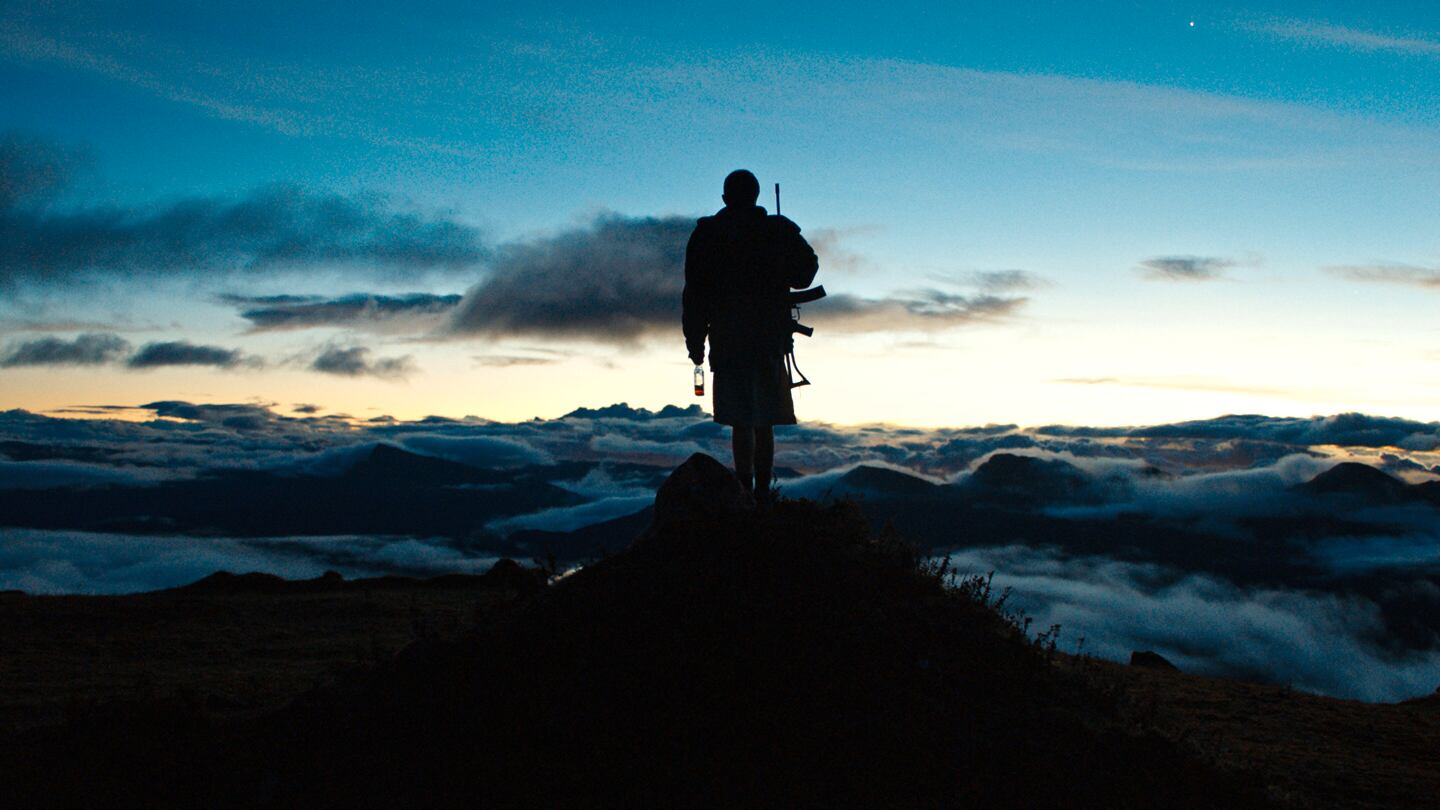A group of Latin American child soldiers who go by names like Rambo, Smurf and Dog. An American engineer known only as Doctora (Julianne Nicholson), whom they keep prisoner in ruins located on a remote, cloud-enshrouded mountain. And a milk cow they’ve received on loan from a local supporter of their rebel cause.
These are the unique ingredients of Monos, a hallucinatory and harrowing journey into a heart of darkness that stands as one of the year’s finest films.
Shot in Colombia but taking place in an unidentified region and during a mysterious conflict, Monos (in theaters Sept. 13) is a direct descendant of Apocalypse Now and Lord of the Flies, although to reduce it to merely a hybrid of those classics is to downplay its own distinctively trippy power. Directed by Alejandro Landes (who co-wrote the script with Alexis Dos Santos), it tells the story of Monos, a band of young male and female fighters that operates under the auspices of a larger Organization whose emissary, the Messenger (Wilson Salazar), is a little person with bulging muscles and a similarly formidable attitude. The Messenger’s arrival at Monos’ hillside outpost results in immediate physical training for the squad, which involves running in place with a fierce intensity that Landes captures in intense close-ups of his protagonists, as well as the delivery of the aforementioned cow, which the Messenger names Shakira and proclaims must be returned to its rightful owner, in due time, unharmed.
ADVERTISEMENT
The leader of Monos is Wolf (Julian Giraldo), who gets permission from the Messenger to be with Lady (Karen Quintero)—thus compelling his mates Bigfoot (Hannah Montana’s Moisés Arias), Smurf (Deiby Rueda), Boom Boom (Esneider Castro), Dog (Paul Cubides), Swede (Laura Castrillón) and Rambo (Sofia Buenaventura) to chop down one of the region’s innumerable trees in order to make them a “wedding” bed.” Such toil is emblematic of this milieu, where physicality is everything. Downtime is spent wrestling and whooping it up, and birthdays are celebrated with belt lashings for each year. Primal aggression reigns supreme, and that goes for the women as well, who routinely situate themselves right in the mix of these aggro melees.
Monos forces Doctora to make videos in which she reads from daily newspapers (thus proving the date of the recordings), but otherwise, she’s kept locked away in a dingy room where, in one of many stunning snapshots of a mind fraying at the seams, she dances wildly, her head hung low, her arm propped against the wall, and her body writhing to a club beat only she can hear. Everyone in Monos exists in something like a fugue state, and that becomes literal when Bigfoot, Boom Boom and Swede find mushrooms sprouting in one of Shakira’s dung piles, and decide to take a munch. Landes visualizes their ensuring trip with up-close-and-personal shots of water dripping off branches, and coitus performed in shimmering water, with down becoming up and vice versa.
The more Monos proceeds, the more it takes on the quality of a disturbing drug reverie. Landes routinely cuts to the oceans of white, billowing clouds that threaten to drown these characters’ makeshift home (in one shot, they basically swallow the mountain peak whole). The fog of war is a gorgeous, all-consuming monster, and it soon leads these child soldiers astray, via an accidental calamity that begets an even more unexpected, and destabilizing, loss of life (and problematic lie). When combat arrives, via bursts of fiery nighttime explosions and gunfire, the group—now led by Bigfoot—heads into the jungle with Doctora in tow.
From cool, misty, heavenly landscapes to lush, verdant terrestrial wilderness, that relocation certainly provides a change of scenery. It does not, however, improve almost anyone’s fortunes, as Monos’ main characters continue to devolve further into primeval beasts. Domination, survival and escape are the pressing concerns of all involved, and their escalating urgency is echoed by Mica Levi’s nerve-grinding score, which segues from heartening flutes to cascading drums and intensifying electronic noises. It’s the sound of the world—and one’s sanity—rupturing, and its disquieting loveliness is matched by cinematographer Jasper Wolf’s panoramas of the story’s dueling settings and the young silhouetted figures that populate it.
Monos is a fable about sex, control, fear and alienation; an allegory about the hopeless self-destruction of war; and a mythic vision of youth gone wild. From its characters’ names—comprised of animal species, pop-culture icons, and bland descriptors—to its anonymous time period and geographic area, the film wades in the abstract while simultaneously providing clear, incisive portraits of its main characters: Bigfoot the wannabe-big shot; Boom Boom the loyal follower; Lady the sweet but conniving hierarchy-climber; and Rambo the sensitive skeptic. Even then, though, fuzziness remains an omnipresent facet of the proceedings, epitomized by the androgyny of Rambo, who’s played by a girl (i.e. the stellar Buenaventura) and yet is frequently referred to as “him”—and who partakes in an early three-way make-out with Wolf and Lady, further blurring any clearly demarcated gender/relationship lines.
Unlike Francis Ford Coppola’s Vietnam epic, Monos isn’t structured as a quest so much as a tumble into ever-rockier terrain. After cutting through the jungle brush, Monos’ members discover that there are only two paths left available to them: descent into greater chaos, or flight back to the “normalcy” of civilization. The latter undoubtedly comes with ramifications of its own, but Landes isn’t interested in real-world sociopolitical context. On the contrary, the option to abandon the revolutionary cause is born of instinct. His film is less about cerebral notions than about base reflexes and compulsions, including those of Doctora, who’s embodied by Nicholson with competing measures of hopelessness and desperate resilience. Like everyone else, she’s been broken down to her animalistic self—a situation that would be pitiful if it didn’t also afford her the strength to retain hope.
Horrifying and lyrical, laconic and harried, Monos is a work of unforgettable sights and sounds: shadowy boys and girls encased in mud, chanting and dancing around a campfire; a Temple of Doom-ish confrontation on a rope bridge; an entrancing motorboat excursion down a tranquil river; a decapitated pig’s head placed before a tied-up prisoner; a plunge into roaring rapids, where millions of tiny bubbles struggle to ascend to the surface. It’s an aesthetic marvel that you don’t just admire—you feel, in all its sticky, muddy, hazy brilliance.






